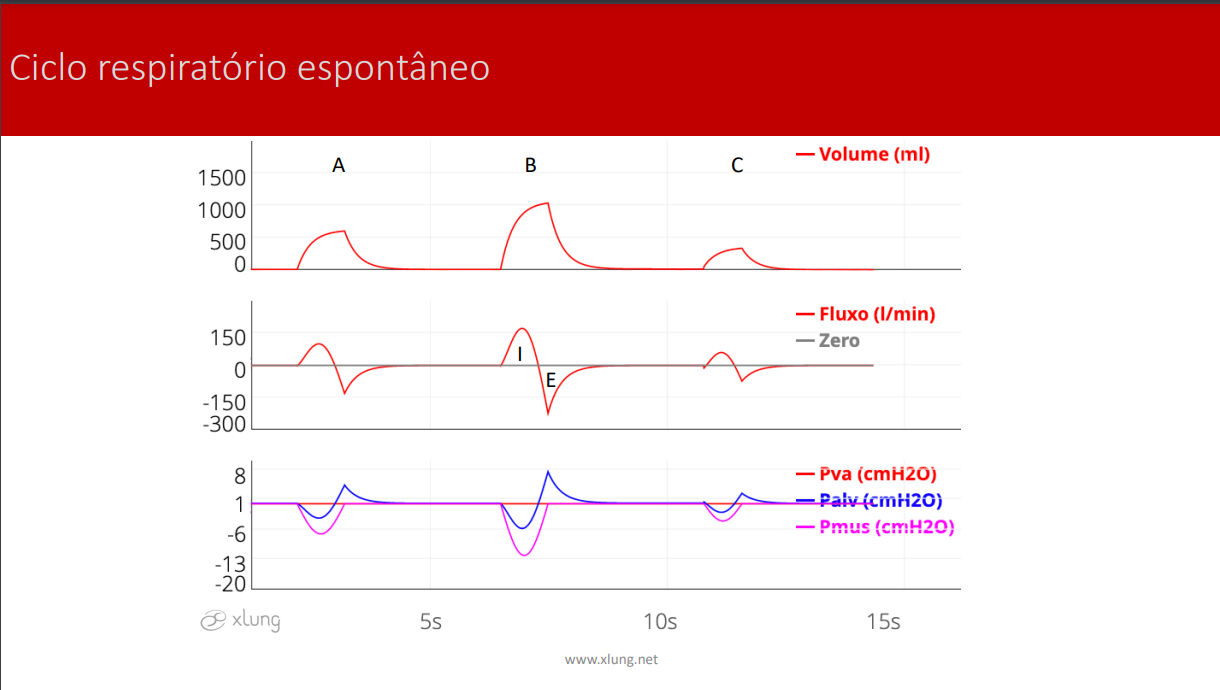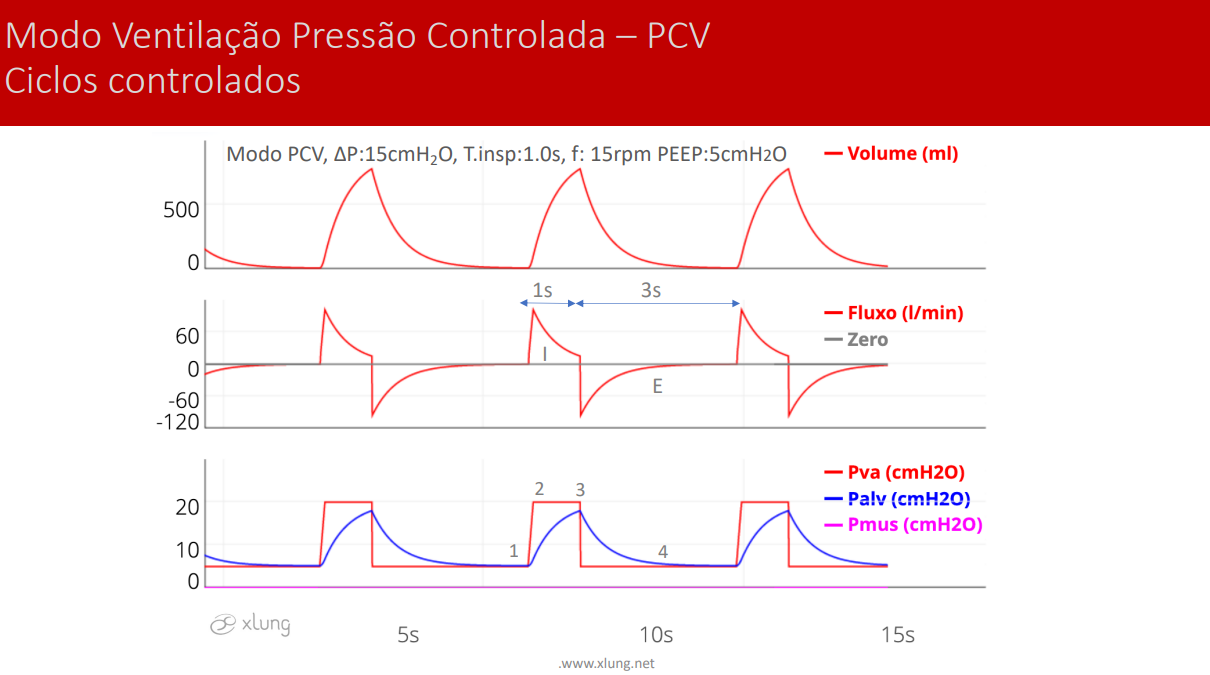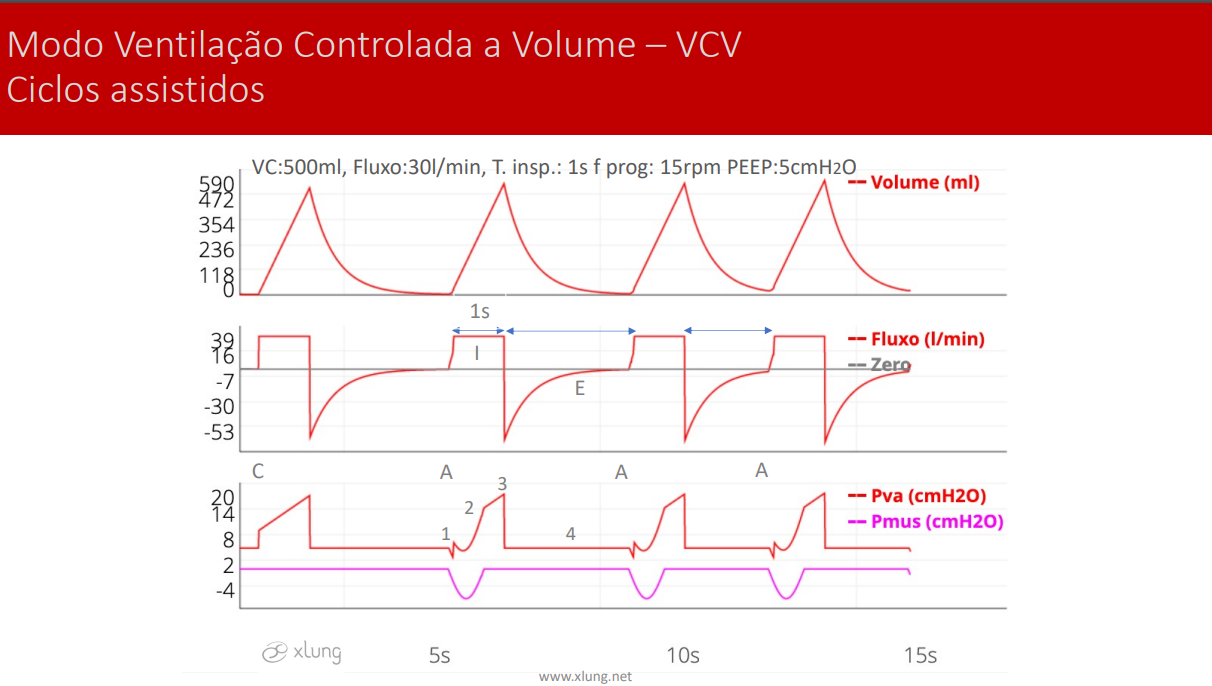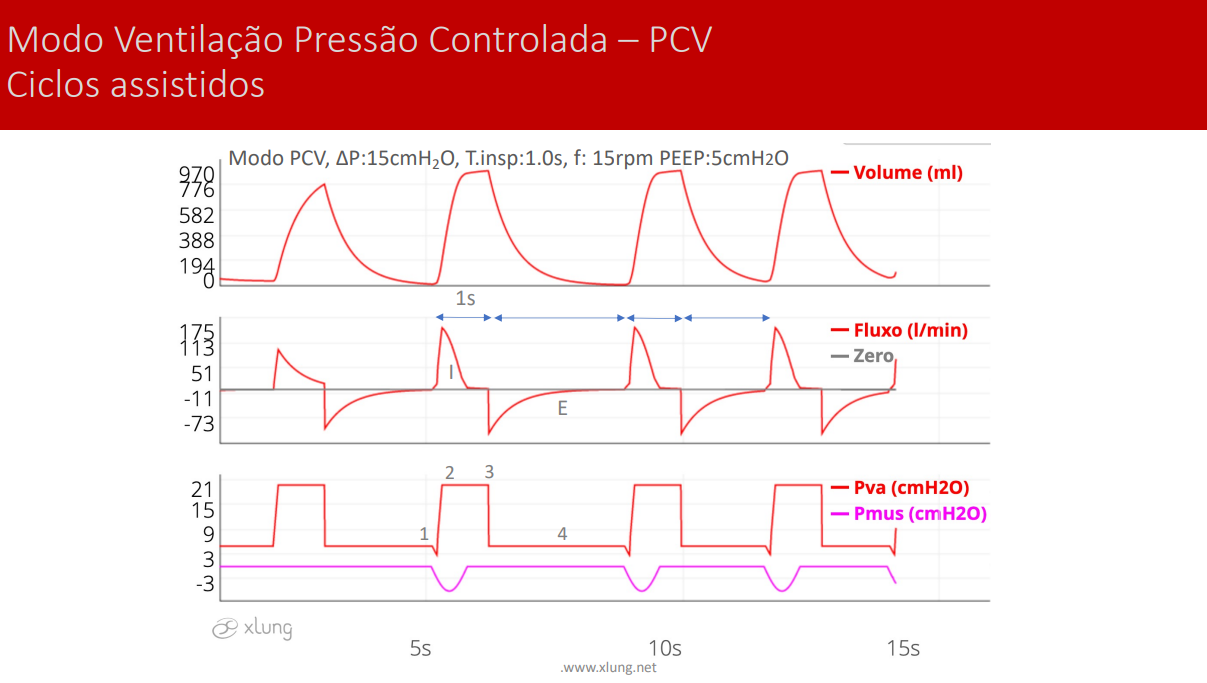Marcelo Alcantara Holanda +
Renata dos Santos Vasconcelos +
Betina Santos Tomaz +
Ao final deste capítulo o leitor deverá estar apto a:
-
Conceituar ciclo respiratório e modo ventilatório
-
Entender os componentes do ciclo respiratório na respiração espontânea e nos modos básicos da ventilação mecânica (VM)
-
Compreender os aspectos elementares dos três modos ventilatórios básicos mais utilizados:
VCV – volume controlado
PCV – pressão controlada
PSV – pressão de suporte
-
Compreender o uso estratégico dos modos ventilatórios básicos
- Ciclos respiratórios e modos ventilatórios, conceitos
- O ciclo respiratório fisiológico ou espontâneo
- Os ciclos respiratórios nos modos ventilatórios básicos
- Uso dos modos ventilatórios básicos e estratégias ventilatórias
- Bibliografia
-
Chatburn RL. Classification of Ventilator Modes: Update and Proposal for Implementation. Respiratory Care, 2007; 52(3): 301-323.
-
Branson R., Chatburn RL, Hess D. Respiratory care equipment, 2nd ed. Philadelphia: Lippincot, 1998.
-
Chatburn RL, primiano FPJr. A new system for understanding modes of mechanical ventilation. Respir Care 2001; 46(6):604-621.
-
Carvalho CRR - Ventilação Mecânica. Volume I – Básico. Clínicas Brasileiras de Medicina Intensiva, São Paulo: Ed. Atheneu, 2000
-
Carvalho CRR - Ventilação Mecânica. Volume II – Avançado. Clínicas Brasileiras de Medicina Intensiva, São Paulo: Ed. Atheneu, 2000.
-
Ward J, Noel C. Basic Modes of Mechanical Ventilation. Emerg Med Clin North Am. 2022 Aug;40(3):473-488.
-
Bonassa J. Ventilação Mecânica: fundamentos e práticas: princípios do funcionamento dos ventiladores artificiais. Rio de Janeiro: Roca, 2016.
Um ciclo respiratório consiste no fenômeno que engloba 4 fases bem distintas de cada movimento respiratório, que são elas: 1. o início da inspiração; 2.a fase de insuflação pulmonar; 3. O fim da inspiração seguido do início da expiração e 4.a fase expiratória contendo a exalação e o período até o início de um novo ciclo respiratório. Na VM define-se modo ventilatório como o processo pelo qual o ventilador pulmonar mecânico determina, seja parcial ou totalmente, quando, como e com que limites os ciclos respiratórios mecânicos são ofertados ao paciente. O modo determina substancialmente o padrão respiratório do paciente durante o suporte ventilatório. Assim, um modo ventilatório determina como essas 4 fases do ciclo respiratório são controladas ou influenciadas pelo ventilador mecânico. Neste capítulo vamos abordar os ciclos respiratórios espontâneos ou fisiológicos e em três modos ventilatórios básicos: volume controlado, VCV, do inglês Volume Controlled Ventilation, pressão controlada, PCV, do inglês Pressure Controlled Ventilation, e a ventilação com pressão de suporte, PSV, do inglês Pressure Support Ventilation.
A figura 1 apresenta o ciclo respiratório fisiológico ou espontâneo sem qualquer suporte ventilatório mecânico.

Figura 1. Ciclo Respiratório Espontâneo. Variações na intensidade do esforço muscular modificam diretamente o fluxo e o volume corrente a partir do efeito sobre a diferença entre a Pressão alveolar (Palv) e a Pressão na via aérea (Pva) A- Normal B-Intenso e C-Fraco. I: Inspiração e E: Expiração
Nesta figura, o esforço muscular inspiratório, representado pela Pmus, varia em intensidade e duração em cada ciclo. A Pmus, ao expandir o volume da caixa torácica, segundo a lei de Boyle, reduz a pressão dos gases alveolares, representado pela pressão alveolar, em azul, a valores um pouco abaixo da pressão atmosférica, considerada o valor zero de referência. Isto gera um gradiente de pressão entre as vias aéreas proximais (narinas e boca) e o parênquima pulmonar. Em consequência deste gradiente ou diferença de pressão, ocorre um fluxo de ar que se desloca do ambiente externo para os alvéolos através das vias aéreas, o fluxo inspiratório. O formato e a intensidade da onda deste fluxo são determinados por este gradiente pressórico e pela resistência das vias aéreas. Ao longo do tempo, um certo volume de ar é insuflado aos alvéolos, ou seja, um volume corrente (VC), que é definido pelo produto: fluxo x tempo. A medida que os alvéolos são insuflados e o parênquima pulmonar é estirado, a pressão elástica do tecido pulmonar se eleva em proporção ao volume corrente inspirado dividido pela complacência dos pulmões e da caixa torácica.
O tempo inspiratório consiste no intervalo que vai desde o início da entrada de ar até o momento em que é atingido o valor máximo do VC. Com a diminuição gradual da Pmus no final da inspiração, seguindo até o relaxamento completo dos músculos inspiratórios, a pressão alveolar, antes negativa, se eleva progressivamente até o ponto em que excede a pressão das vias aéreas proximais, que se mantém zero. Ao atingir esse ponto, a onda de fluxo se inverte em direção ao ambiente externo a partir dos pulmões, e então o ar vai fluir de dentro para fora dos pulmões, iniciando-se a expiração. Por convenção, a onda de fluxo expiratória tem sinal negativo. O ar é expirado passivamente, impulsionado pela pressão alveolar que se encontra elevada no instante final da inspiração devido ao aumento da retração elástica pulmonar e do relaxamento da musculatura inspiratória. A exalação acontece segundo a constante de tempo do sistema respiratório, que consiste no produto da Raw x Cst, até o momento em que a pressão alveolar se iguala novamente com a pressão das vias aéreas quando o fluxo cessa. O tempo expiratório é computado como o intervalo que dura do início do fluxo expiratório até o começo da inspiração subsequente.
Cabe ao centro respiratório, localizado no bulbo, todo o controle deste processo, sendo o mesmo determinado por complexos mecanismos envolvendo, entre outros elementos, impulsos neurais aferentes de quimiorreceptores periféricos e centrais, mecanorreceptores nos pulmões e caixa torácica, do córtex cerebral e de outras regiões do sistema nervoso central. É neste complexo mecanismo do ciclo respiratório que atua o ventilador pulmonar mecânico. Não surpreende que o suporte ventilatório ainda apresente grandes limitações apesar de grandes avanços tecnológicos nas últimas décadas.
O suporte ventilatório artificial é essencialmente um processo que substitui total ou parcialmente a ação dos músculos inspiratórios e o controle neural da respiração. Dois tipos fundamentais de ciclos respiratórios podem ser definidos na ventilação mecânica: ciclos respiratórios controlados e ciclos respiratórios assistidos. Um primeiro, em que o ventilador “controla” toda a fase inspiratória, ou seja, substitui totalmente o esforço muscular respiratório e o controle neural do paciente. Este ciclo será aqui denominado de controlado. No segundo tipo, o ventilador apenas auxilia ou assiste a musculatura inspiratória que se encontra ativa, sendo aqui denominado de ciclo assistido. Alguns autores utilizam o termo “ciclo espontâneo” para definir o ciclo que ocorre durante a oferta da ventilação com pressão de suporte (PSV, pressure support ventilation) ou de pressão inspiratória (IPAP). Em vez disso, o termo assistido será aqui usado para designar este último tipo de ciclo, mantendo-se uma coerência com a definição acima apresentada e com o emprego da terminologia de ciclo espontâneo apenas para a respiração fisiológica, ou seja, o ciclo respiratório de um indivíduo sem uso de ventilação mecânica.
O momento de início dos ciclos respiratórios na VM é denominado disparo ou trigger (gatilho) em inglês. O disparo pode ser pelo próprio ventilador, ou seja, iniciado pelo mesmo em intervalo ou janela de tempo estabelecido a partir de uma frequência pré-determinada, ou pelo paciente, através de um mecanismo sensível (ajuste de sensibilidade ou trigger function) ao esforço muscular respiratório. Assim, os ciclos controlados são aqueles disparados pelo ventilador, e os assistidos pelo paciente.
3.1. Ciclos respiratórios controlados nos modos VCV e PCV
Além destas duas grandes divisões, o ciclo do ventilador pulmonar também pode ser classificado quanto às variáveis que são controladas durante a inspiração: sejam elas volume, tempo, fluxo ou pressão ou mesmo a combinação de duas ou mais destas.
Assim um ciclo dito controlado pode ser ciclado ou controlado a volume (modo VCV), ou seja, programado para findar ou “ciclar” quando se atinge um valor pré-determinado de volume corrente (VC) ou pode ser com pressão controlada e ciclado a tempo (modo PCV) programado para findar ou “ciclar” quando se atinge um valor pré-determinado de tempo inspiratório (Ti) nesse caso mantendo constante a pressão na via aérea na inspiração.
A figura 2 apresenta ciclos controlados a volume em modo VCV.

Figura 2. Modo Ventilação Controlada a Volume (VCV). Ciclos respiratórios controlados: volume corrente, tempo inspiratório e fluxo (tipo quadrado ou constante nesse caso) são fixos. O tempo expiratório máximo também é constante e determinado pelo tempo inspiratório e pela frequência respiratória programada (15rpm). As 4 fases do ciclo respiratório são apresentadas na curva de pressão: 1: o disparo (trigger) é determinado pelo ventilador mecânico a um intervalo de tempo de 4 segundos, 2: a fase de insuflação pulmonar; 3: o fim da inspiração e início da expiração, a ciclagem e 4: a exalação e o tempo até o início do próximo ciclo respiratório. I: Inspiração e E: Expiração.
Na figura 2 três ciclos respiratórios mecânicos controlados e ciclados a volume são apresentados. Nesta situação, o esforço muscular respiratório é zero. O VC foi ajustado em 500ml (0,5l). Além do VC, a intensidade e o padrão da onda de fluxo são determinados pelo operador do ventilador. Desta forma, o tempo inspiratório é pré-definido, resultado da razão do VC/fluxo. O fluxo foi ajustado em 30l/min (0,5l/s). Assim o tempo inspiratório será de 1s (0,5l/0,5l/s). O tempo expiratório dependerá da frequência respiratória programada. Nesse caso ela está programada em 15 rpm. Logo o tempo total do ciclo respiratório será de 60s/15rpm=4s. O disparo do ciclo (fase 1, trigger) é assim determinado pelo ventilador mecânico, a um intervalo ou janela de tempo de 4 segundos O tempo expiratório será de 4s menos o tempo inspiratório de 1s, 4-1=3s. Assim a relação inspiração / expiração é determinada como 1:3 nesse exemplo, ou seja, o tempo expiratório é 3 vezes o tempo inspiratório. A fórmula para relação I:E é 1:T. exp./ T. inspiratório. A insuflação ou fase 2 do ciclo respiratório se dá pelo fluxo constante o que promove aumento da pressão na via aérea e alveolar ao longo de toda a inspiração. O critério para a mudança da inspiração para a expiração (fase 3, ciclagem) é o alcance do VC programado. Como ocorre no ciclo espontâneo, o ar é expirado passivamente pelo aumento da pressão elástica pulmonar (pressão alveolar). O ventilador interrompe a entrada de ar, zera o fluxo, e abre a válvula exalatória, ou seja, promove a ciclagem da inspiração para a expiração. Note que a expiração se processa até que a pressão alveolar retorne a um valor pré-determinado, neste caso, acima de zero, a PEEP (fase 4).
Na prática a ventilação controlada ciclada a volume é bastante fácil de ser ajustada, bastando definir-se um VC alvo, por exemplo, 8ml/kg de peso ideal, e ajustando-se o fluxo para se garantir um Ti ao redor de 0,6 a 1,2s, a depender claro da estratégia ventilatória específica recomendável para um determinado paciente. O tempo expiratório disponível será determinado pelo ajuste da frequência respiratória. Os ajustes finos e algumas variações presentes em alguns ventiladores do modo VCV serão apresentados no capítulo específico dedicado ao mesmo.
A figura 3 apresenta ciclos controlados em modo pressão controlada (constante), ou seja, em PCV.

Figura 3. Modo Pressão Controlada (PCV). Em ciclos respiratórios controlados a pressão aplicada acima da PEEP (ΔP) e o tempo inspiratório são programados. O tempo expiratório máximo também é constante e determinado pelo tempo inspiratório e pela frequência respiratória programada (15rpm). O disparo (trigger) nestes ciclos é determinado pelo ventilador mecânico a um intervalo de tempo de 4 segundos nesse caso. I: Inspiração e E: Expiração.
No modo PCV apenas a pressão aplicada sobre a PEEP (ΔP) e a sua duração (tempo inspiratório) são fixos pelo operador, enquanto o volume corrente e o fluxo inspiratório não são controlados. No exemplo, a relação I:E é de 1:3 uma vez que a frequência respiratória aplicada é de 15 rpm com uma duração de inspiração de 1.0s. O fluxo adota um padrão de desaceleração exponencial conforme as propriedades mecânicas do sistema respiratório como a resistência de vias aéreas, a complacência total do sistema (pulmão e caixa torácica) e a constante de tempo (produto Rva x Cst). Os ajustes finos e algumas variações de ajustes presentes em alguns ventiladores do modo PCV serão apresentados no capítulo específico dedicado ao mesmo.
3.2. Ciclos respiratórios assistidos nos modos volume controlado (VCV), pressão controlada (PCV) e ventilação com pressão de suporte (PSV)
Uma situação mais complexa ocorre quando o comando neural (drive) e a musculatura do sistema respiratório do paciente estão ativos, ou seja, quando o paciente, participa em algum grau, da ventilação, como por exemplo pacientes acordando do uso da sedação. Neste caso os ventiladores mecânicos monitorizam a “demanda” do paciente através da mensuração contínua do fluxo e/ou pressão no circuito do ventilador. O ajuste de “sensibilidade”, determina o limiar de variação de fluxo ou pressão que será reconhecido pelo ventilador como esforço muscular do paciente. Uma sensibilidade bem ajustada é crucial para que o paciente seja capaz de deflagrar ou disparar ciclos respiratórios quando assim desejar. Um ajuste de sensibilidade a pressão de -1 a -2cmH2O ou a fluxo de 2 a 4l/min são recomendáveis. Sabe-se que o ventilador dispara mais facilmente com a sensibilidade a fluxo, embora o valor clínico deste recurso seja discutível. As figuras 4 e 5 apresentam ciclos do tipo VCV e PCV, respectivamente, no paciente com esforço muscular caracterizando os ciclos assistidos desses modos.

Figura 4. Modo Ventilação Controlada a Volume (VCV). Ciclos respiratórios controlados e assistidos: volume corrente, tempo inspiratório e fluxo (tipo quadrado ou constante nesse caso) são fixos. O tempo expiratório máximo também é constante e determinado pelo tempo inspiratório e pela frequência respiratória programada (15rpm). A sensibilidade é a pressão e os três últimos ciclos são do tipo assistidos, isto é, disparados pelo paciente. As 4 fases do ciclo respiratório são apresentadas na curva de pressão de um deles: 1: o disparo (trigger) determinado pelo esforço do paciente ao reduzir a pressão na via aérea e atingir o limiar de sensibilidade ajustada no ventilador; 2: a fase de insuflação pulmonar com depressão da pressão da via aérea (concavidade) causada pelo efeito da pressão muscular; 3: o fim da inspiração e início da expiração, a ciclagem e 4: a exalação e o tempo até o início do próximo ciclo respiratório. Notar a variação do tempo expiratório de acordo com a frequência do paciente. I: Inspiração, E: Expiração, C: Controlado, A: Assistido.

Figura 5. Ventilação Pressão Controlada (PCV), ciclos respiratórios controlados e assistidos: a pressão aplicada acima da PEEP (ΔP), tempo inspiratório são fixos. A sensibilidade é a pressão e os três últimos ciclos são do tipo assistidos, isto é, disparados pelo paciente. As 4 fases do ciclo respiratório são apresentados na curva de pressão de um deles: 1: o disparo (trigger) determinado pelo esforço do paciente ao reduzir a pressão na via aérea e atingir o limiar de sensibilidade ajustada no ventilador, 2: a fase de insuflação pulmonar com a pressurização da via aérea e a oferta de fluxo em sincronia com o esforço muscular inspiratório com manutenção da pressão constante independente do grau de variação da Pmus; 3: o fim da inspiração e início da expiração, a ciclagem e 4: a exalação e o tempo até o início do próximo ciclo respiratório. Notar a variação do tempo expiratório de acordo com a frequência do paciente. I: Inspiração, E: Expiração, C: Controlado, A: Assistido.
Comparando-se ciclos assistidos VCV e PCV há uma grande diferença quanto a resposta do ventilador à demanda muscular do paciente. Em VCV o aumento da demanda ou esforço muscular respiratório não é acompanhado de resposta correspondente de aumento de fluxo por parte do ventilador mecânico. Isso pode ser percebido como desconforto pelo paciente. Já em PCV, o ventilador, ao aumentar a oferta de fluxo e de VC em proporção e de forma mais sincronizada ao esforço do paciente o que torna esse modo superior ao primeiro quanto a adaptação do paciente à VM invasiva.
Além dos ciclos assistidos em VCV e PCV, os ventiladores dispõem de um terceiro tipo de modo destinado exclusivamente a pacientes com drive ventilatório e esforço muscular presentes, a Ventilação com Pressão de Suporte (PSV, do inglês Pressure Support Ventilation). Os ciclos assistidos com PSV são semelhantes aos ciclos em PCV, exceto pelo mecanismo de ciclagem, sendo este ciclado a fluxo e aquele a tempo. A figura 6 ilustra o princípio de funcionamento do modo PSV.

Figura 6. Ventilação com Pressão de Suporte (PSV), somente ciclos respiratórios assistidos: a pressão aplicada acima da PEEP é a Pressão de Suporte (PS) ofertada na inspiração. Este parâmetro e o critério para ciclagem, um percentual geralmente pré-ajustado em 25% do pico de fluxo inspiratório, são controlados em todos os ciclos e ajustáveis no ventilador. As 4 fases do ciclo respiratório são apresentados na curva de pressão de um deles: 1: o disparo (trigger) determinado pelo esforço do paciente (Pmus) ao reduzir a pressão na via aérea e atingir o limiar de sensibilidade; 2: a fase de insuflação pulmonar com a pressurização da via aérea e oferta de fluxo em sincronia com o esforço muscular com manutenção da PS independente de variação da Pmus; 3: o fim da inspiração e início da expiração, a ciclagem, que se processa quando o fluxo inspiratório, ao desacelerar, atinge, nesse caso, 25% do pico de fluxo inspiratório do mesmo ciclo; 4: a exalação até o próximo ciclo respiratório. Notar as variações dos tempos inspiratório, expiratório, fluxo e volume corrente em resposta às variações da Pmus. I: Inspiração, E: Expiração.
Nos ciclos em PSV a possibilidade de variabilidade de fluxo, VC e Ti pode favorecer a um maior sincronia e conforto para os pacientes. O leitor deve se reportar ao capítulo específico desse modo ventilatório particular que incorporou algumas inovações tecnológicas permitindo um ajuste fino visando maior sincronia paciente ventilador.
A figura 7 resume as principais características dos três modos ventilatórios básicos aqui apresentados.
Como se demonstra na figura 7 há vantagens e desvantagens de cada modo ventilatório básico. No nosso entender a escolha de um ou de outro deve ser guiada pela estratégia ventilatória para cada paciente ao longo da evolução do seu quadro clínico. O modo VCV pode ser muito útil quando se deseja implementar uma ventilação mecânica protetora com rigoroso ajuste do VC, do tempo inspiratório e do volume minuto (VE) o que implica em manutenção por de uma mecânica respiratória sob controle mais direto e de uma troca gasosa idem. Além disso, ele possibilita medidas acuradas de resistência de vias aéreas e de complacência estática do sistema respiratório que podem ajudar na condução clínica e titulação de parâmetros. Já o modo PCV por usa vez, embora possa ser usado também com ciclos controlados, oferece a vantagem de aumentar a autonomia ventilatória do paciente que apresenta drive ventilatório, permitindo ao paciente oferta de fluxo e VC de acordo com suas demandas que podem variar ciclo a ciclo. Uma situação comum consiste na transição de um cenário em que a sedação profunda ou mesmo o bloqueio neuromuscular são reduzidos ou suspensos. O modo PCV assegura um tempo inspiratório e uma frequência respiratória mínima de base o que pode evitar períodos de hipoventilação em pacientes parcialmente sedados ou com efeitos residuais de drogas que deprimem o drive ventilatório e a força muscular respiratória. Já o modo PSV é ideal para o paciente alerta, em preparo para ou já em fase de desmame da VM até o momento pré-extubação. Obviamente, trata-se aqui de opinião dos autores deste capítulo. É certo que cada cenário requer uma avaliação da efetividade do modo e de seus parâmetros em atingir os objetivos fisiológicos e clínicos definidos para cada paciente em particular. Aprofundaremos essa questão dentro de cada capítulo correspondente a cada um dos modos.
Obviamente, trata-se aqui de opinião dos autores deste capítulo. É certo que cada cenário requer uma avaliação da efetividade do modo e de seus parâmetros em atingir os objetivos fisiológicos e clínicos definidos para cada paciente em particular. Aprofundaremos essa questão dentro de cada capítulo correspondente a cada um dos modos.
